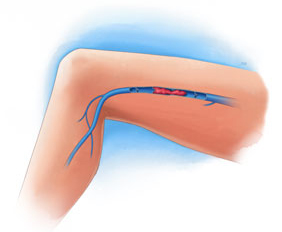
Deep Vein Thrombosis (DVT)
Blood clot occurring in deep veins
Deep vein thrombosis occurs when a blood clot forms in the deep veins of the body – usually in the leg. While deep vein thrombosis is a fairly common condition, it is also very dangerous. If the clot breaks away and travels through your bloodstream, it could end up in the lungs as a pulmonary embolism – a potentially fatal condition.
Deep vein thrombosis is often the result of blood-clotting abnormalities, periods of inactivity, stenosed veins and trauma or injury. Symptoms of deep vein thrombosis include pain, swelling and discoloration around the area of the clot.
Deep vein thrombosis can often be treated in the hospital with a minimally invasive, catheter-directed procedure that infuses “clot dissolving” medication into the veins. Treatment may also involve the use of anticoagulants and prescription grade compression stockings.
Superficial Vein Thrombophlebitis (SVT)
Caused by blood clot in superficial veins
Superficial vein thrombophlebitis is vein inflammation due to a blood clot located just below the skin’s surface. The clot causes pain, irritation, and may hinder blood flow. Superficial vein thrombophlebitis is generally caused by an injury to the vein and appears in veins where blood flows slower than normal (such as varicose veins). Treatment options include anti-inflammatory medication and warm compresses.
Related Content



